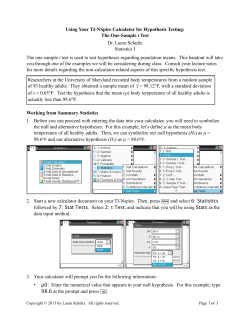
Application Exercise 7 Section Number: _____________ Team Member Information:
Application Exercise 7 Section Number: _____________ Team Member Information: No. 1 Name USC ID 2 3 4 5 Page 1 of 7 Weekly Wages Differences One of your BUAD 310 professors came across an interesting Wall Street Journal article from May 23, 2014 titled “Study: Skilled Foreign Workers a Boon for Pay.” (See Appendix A.) The authors of the study kindly provided the data to us in the Excel file data_wsj.xlsx. Your discussion professor will describe the data to you at the beginning of the class. We will only use the column labeled “differences”. The differences column is: differences = (% change in weekly wages of native college educated 1990-2010 ) – (% change in weekly wages of native NON college educated 1990-2010) Consider the differences as a random sample. The following population parameter is of interest to us: μ = population mean of differences (as defined above) We’ve given you the histogram and boxplot of the differences below. The histogram shows that the differences are approximately normal. Answer the questions based on the information given. The number of points for each question is indicated in the square brackets: []. There are 10 questions. Page 2 of 7 1. Using Excel, fill in the table below. Round your answers to 2 decimal places and use these rounded values for the rest of the questions. (Use Excel’s STDEV.S function to get the standard deviation.) [3] Sample Size = Sample Mean = Sample Standard Deviation = 2. Identify the metropolitan area with the largest difference. (Hint: There are multiple ways to do this. Sorting is one way. Another way is to inspect the box plot and “filter” the data.) [2] Put final answer here: ________________________ 3. Identify the metropolitan area with the smallest difference. [2] Put final answer here: ________________________ 4. We like to conduct a hypothesis test at α = 0.05 to see if the % change in weekly wages for the native college educated is greater than the % change in weekly wages for the native non college educated on average. Which one of the tests corresponds to our question of interest? Circle one. [2] a) H0: μ > 0 vs Ha : μ > 0 b) H0: μ < 0 vs Ha : μ < 0 c) H0: μ > 0 vs Ha : μ < 0 d) H0: μ < 0 vs Ha : μ > 0 e) H0: μ ≤ 0 vs Ha : μ > 0 f) H0: μ ≤ 0 vs Ha : μ < 0 g) H0: μ > 0 vs Ha : μ ≤ 0 h) H0: μ < 0 vs Ha : μ ≤ 0 Page 3 of 7 5. Using Excel or by hand compute the value of the test statistic. Round to 2 decimal places. [4] Test statistic value to 2 decimal places: ______________ 6. Assuming the null hypothesis you picked is true, what is the distribution of the test statistic? Circle one. [2] a) Normal with mean 0 and sd 1 b) Normal with mean and sd equal to the values we got from question 1 c) Normal with degrees of freedom equal to the sample size minus 1 d) T distribution with mean 0 and sd 1 e) T distribution with mean and sd equal to the values we got from question 1 f) T distribution with degrees of freedom equal to the sample size minus 1 7. Find the p-value using Excel. Depending on which answer you picked for question 6, you’ll either use NORM.DIST or T.DIST function but only one is correct. Also remember that p-values are probabilities. As long as you have correctly carried out the hypothesis test, you should not be surprised by p-values near 0 or 1. Report the p-value to 2 decimal places. [2] Function used (explicitly state either NORM.DIST or T.DIST): _________________ P-Value to 2 decimal places: ______________ (Excel has a built-in function that does the test automatically. See Appendix B for details. If you have time you can use it to verify your answer. You are NOT required to look at or use Appendix B.) Page 4 of 7 8. What should be your correct decision and the concluding statement? Circle one. [2] a) We reject the null hypothesis; we have sufficient evidence to support the hypothesis that on average the % change in weekly wages for the native college educated is greater than the % change in weekly wages for the native non college educated. b) We reject the null hypothesis; we do not have sufficient evidence to support the hypothesis that on average the % change in weekly wages for the native college educated is greater than the % change in weekly wages for the native non college educated. c) We fail to reject the null hypothesis; we have sufficient evidence to support the hypothesis that on average the % change in weekly wages for the native college educated is greater than the % change in weekly wages for the native non college educated. d) We fail to reject the null hypothesis; we do not have sufficient evidence to support the hypothesis that on average the % change in weekly wages for the native college educated is greater than the % change in weekly wages for the native non college educated. 9. Recall that the formula for the confidence interval of a population mean is given by: X t / 2 s . n Use Excel’s T.INV function to find t / 2 to 5 decimal places. (We like to make sure you understand where t / 2 value comes from.) [2] t / 2 value to 5 decimal places: _______________________________________ 10. Use Excel’s CONFIDENCE.T function to find the 95% confidence interval for μ. Round the bounds to two decimal places. Note that CONFIDENCE.T gives the margin of error which is t / 2 s . [4] n Conf. int. in the form (lower limit, upper limit):____________________________________ Page 5 of 7 Appendix A Page 6 of 7 Appendix B Here’s a screen shot of how you can use the Excel’s T.TEST function to get your p-value. Note that due to numerical implementations, there may be some minor discrepancy with the p-value you get from question 7. Page 7 of 7
© Copyright 2025









